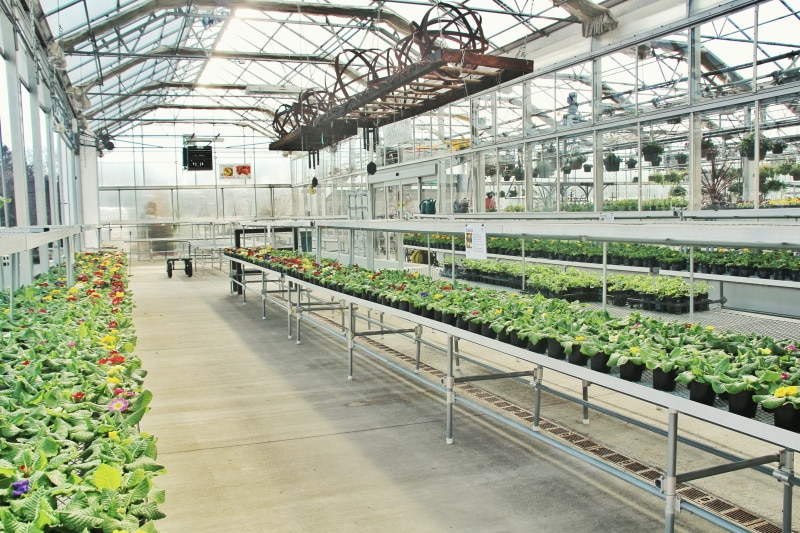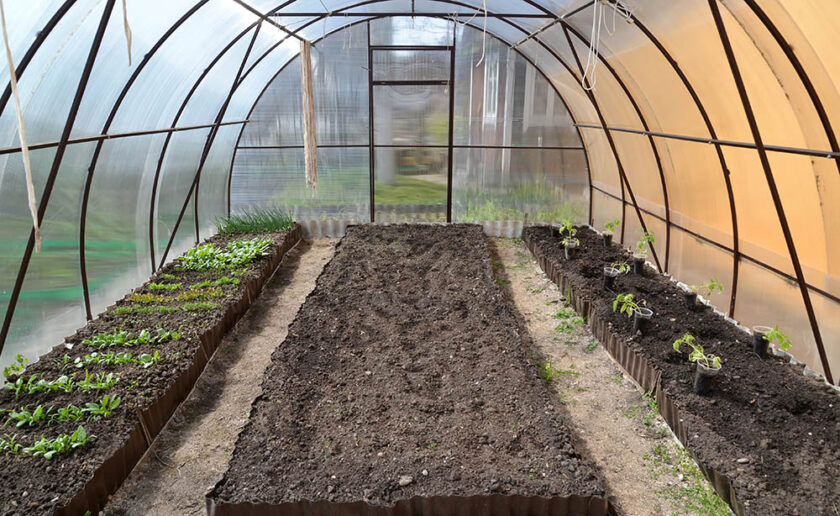What Is a Plant Nursery? Types, Facts, & FAQ
-

- Last updated:

As we look out the window and admire the neighbor’s rose bush or stop at the local farmer’s market for apples and tomatoes, we may fail to appreciate what it takes to grow these flowers and vegetables. The germination process begins long before the plants bloom in your yard or the vegetables reach your table. The plants are nurtured and raised on farmlands or in greenhouses for private or commercial use. A plant nursery is a place that starts the growing process for plants and trees.
What Is a Plant Nursery?
The plants are started with seedlings or seeds and are grown to a size that is desirable to farmers, landscapers, retail stores, and home gardeners. The plants are used in landscapes, lawns, vegetable gardens, and other indoor and outdoor plant and flower aesthetics.
Plant nurseries range in size from private backyard nurseries to large plots of land and can specialize in fruits and vegetables or exotic trees and shrubs. The types of plants and trees that are grown in the nursery will depend on the market demand and region.
Once grown, plant nurseries sell many types of plants and trees to wholesale and retail nurseries. These nurseries are where customers can purchase a wide range of plants or young trees for farms, gardens, and more. These garden centers are also the place to go when you want information or advice about plants, soil, fertilizers, garden tools, and more.

How Do Nurseries Operate?
There are a variety of ways for a nursery to care and grow plants. Shrubs and small trees that are sold in garden centers need to be grown in containers while ornamental trees will need open fields to thrive. There are plants that will need to be shielded from outdoor elements while having access to sunlight. Such plants will need to be protected, grown, and cared for in greenhouses or plastic tunnels. Greenhouses are building structures used by nurseries for seedlings and saplings. The controlled environment allows the plants to grow and survive during the colder months. They are also used by nurseries to grow non-native and exotic plants.
Greenhouses are equipped with advanced features like automated ventilation, temperature control, and irrigation systems. Advanced greenhouses can open the roof to expose the plants to the outdoors gradually without having to move them out of the greenhouse.
Human laborers are a necessary and important part of the plant growing business, however. Caring for growing plants requires continual hands-on care and observation to ensure that the plants are safe and thriving and cannot be replaced with machinery.
With so many variables affecting the success of the growing plants, nurseries use automated systems to do the watering and temperature adjustments, but the human hands and eyes are necessary also.
Nursery Classification
Nurseries can be large commercial entities or private greenhouses.
- Commercial: Commercial nurseries are for profit businesses that grow and sell plants to customers primarily for profit.
- Private: Plants that are grown by individuals primarily for personal use.

What Are the Different Types of Plant Nurseries
There are four types of plant nurseries.
- Wholesale Nursery: A wholesale nursery is a large-scale provider of plants for customers like landscapers, retailers, and wholesale liner nurseries. Wholesale nurseries will focus primarily on flowers and plants and sell to garden centers and florists or cater to a range of markets that includes vegetables, fruits, and plants for landscaping.
- Retail Nursery: A retail nursery is usually the local garden center that sells garden and landscape supplies like larger size plants and flowers, fertilizers, garden tools, yard decorations, and more. Retail nurseries may also specialize in bulbs, roses, tropical plants, or citrus trees. Most retail nurseries purchase the plants from wholesale nurseries and resell them to their retail customers. Most retail nurseries do not grow the plants from seeds or saplings.
- Mail-Order Nursery: Like retail nurseries, some mail-order nurseries purchase the plants they sell from whole nurseries. There are some that continue to grow their own plants, however.
- Private Nursery: A private nursery grows plants for one individual. The plants may be for one individual or one individual client like a corporation, institution, or estate.
What Makes Up a Plant Nursery
- Building/Shed: Nurseries require structures for the office, sales counter, potting shed, packing shed, store, equipment sheds, and living space.
- Progeny Tree Block: The type and variety of plants and the mother plant collection that contributes to the success of the plant nursery.
- Propagation Structures: The successful growth of plants relies on the environment where they are housed. Structures like glass houses, poly houses, hot beds, greenhouses, lath houses, cold frames, mist houses and shade houses are essential to most plant nurseries.
- Seed Bed: Seed beds are small areas where seeds are planted, and the germination of seeds can be observed and monitored.
- Nursery Bed: Once the seeds become saplings, they are removed from the seed bed and grown in the nursery bed. Nursery beds provide separate sections for each crop that is being grown.
- Pot Yard: The pot yard is used to grow plants that are not hardy and may require plenty of shade.
- Packing Shed/Working Yard: The part of the nursery that sorts and packs the saplings to get them ready to be sold.

How Do Greenhouses Work?
Plants need the proper light, temperature, water, nutrients, and air to live and grow. There are many different plants, and they all have unique needs to survive. Greenhouses ensure that new plants are provided with the proper light and warm temperatures they require to survive. Once the plants leave the nursery, it is up to the plant owner to provide the proper water, air, and nutrients for the plant to live and grow.
Greenhouses are made mostly of transparent plastic or glass. The translucent materials allow the light to come in and provide the plants with the optimum amount of sunlight. The sun comes into the greenhouse through the glass and is absorbed by anything in the structure. For instance, the plants and the ground soak up the sun and convert it to heat in the building. The heat is trapped in the building and provides warmth to the plants.
On days when sunlight is scarce, it may take a long time for the greenhouse to heat up. There are cloudy days when it may not heat up at all. On a sunny day, greenhouse temperatures can become quite high, however, and the greenhouse needs to be ventilated to prevent the plants from being cooked. Although the greenhouse can get hot, it is best to have it in an area that gets enough sunlight.
Plants need the right conditions to survive and grow. Greenhouses provide the light and warmth for photosynthesis to occur and provide the plants with food. The required amount of sunlight varies among plants, although the average is about six hours per day.
- Increased number of crops
- Excellent conditions for plants
- Can grow exotic plants
- Plants are protected from storms
- Protection from droughts
- Protection from invasive plant species and animals
- Pest control
- Plants grow all year
- Greenhouse farming can be profitable
- Ability to maximize profits
- Greenhouses require expert set-up
- Costly
- Success is dependent on expert knowledge of growing crops
- High maintenance
- Mistakes can lead to the spread of pests
- Issues with pollination
- Long term commitment
- Requires official permissions
- Vulnerable to theft and vandalism
- Plant nurseries provide small beds for young seedlings. It is easier and more cost-effective to give seedlings the special care and attention they need.
- Mist chambers in a nursery provide the best environment for plant grafts and cuttings.
- Fruit crop cuttings require special care before being transplanted in the main field. The controlled conditions in a nursery provide an environment for skilled laborers to give the propagules care they need to thrive and prepare them for being transplanted.
- Planting seeds in the soil is less successful than transplanting plants that were raised from seedlings in a nursery.
- Since damaged plants need to be replaced during the present or following year of planting, using hardened nursery plants instead of seeds for orchards is preferred over re-planting seeds. Sowing or planting seeds when done after the original planting will likely be unsuccessful due to weed management. Nurseries and their stumps and plants are essential for replacing casualties in orchards.
- Nurseries provide time to prepare and plan the planting operations for saplings and seedlings.
- Nurseries provide seedlings with a slow introduction to outdoor conditions like full sun and wind.
- Nurseries provide an environment for plants that do not produce seeds every year. During the times of healthy seed production, nurseries can sow the seeds so they can thrive and be transplanted in the future.
- Invasive weeds can overwhelm slow-growing seedlings. Nurseries can raise these seedlings until they are strong and can be planted in the main field.
- Plants grown in the nursery are the best for rebuilding and restoring degraded soil on farming sites.

Fun Facts About Greenhouses
- A greenhouse is a building that is enclosed primarily in glass and has a controlled environment.
- Greenhouses are made mostly out of glass and other materials that are transparent.
- Greenhouses need a special horticulture grade glass.
- Horticulture-grade glass cannot have any bubbles. Bubbles in the glass can magnify the sun and burn the plants.
- Greenhouses vary in size and can be a small structure in a backyard or a large commercial warehouse.
- Backyard greenhouses are usually for individual use and range between 50 to 200 square feet.
- Commercial greenhouses can be quite large. In some instances, they can exceed 100,000 square feet.
- The idea to grow plants in a controlled environment began in Ancient Rome.
- There are more benefits to growing plants in a greenhouse rather than in a home or outside.
- Greenhouses encourage the growth of plants through a process called photosynthesis. Grow lamps can also be used in instances when the sun is absent.
- Greenhouses allow plant growers to control the temperature and humidity in the structure. This creates the perfect environment for growing specific plants.
Conclusion
A nursery is the place to go if you want to find a nice variety of healthy plants. Whether you are looking for some exotic houseplants, garden flowers, or fruits and vegetables, nurseries usually have a wide range of plants to choose from. While you are there, you may find some unique garden décor, and you can get some expert advice on weed control, fertilizers, and other lawn and garden issues.
- Related Read: 8 Great Greenhouse Flooring Types (with Pictures)
- https://www.agrifarming.in/plant-nursery-information-beginners
- https://apnursery.com/blog/types-of-plant-nurseries/#1
- https://gardensnursery.com/nurseries-operate/#:~:text=A%20nursery%20is%20a%20place,plants%20and%20trees%20via%20mail.
- https://environmental-conscience.com/greenhouses-pros-cons/
- https://www.factsjustforkids.com/plant-facts/greenhouse-facts-for-kids/
- https://garden.lovetoknow.com/wiki/How_Does_a_Greenhouse_Work
Featured Image Credit: Piqsels
Contents

